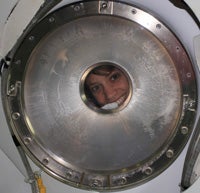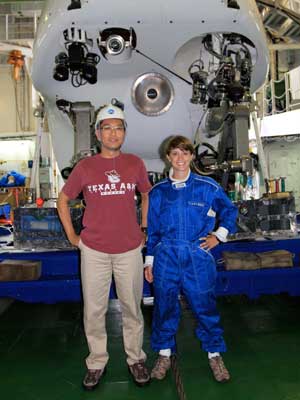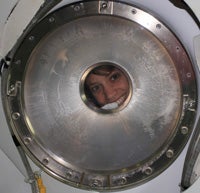 NARRAGANSETT, R.I. – March 1, 2012 – University of Rhode Island graduate student Maryjo Brounce made the most of her first trip aboard an oceanographic research vessel and her first time in a submersible vehicle traveling to the seafloor. The Levittown, Pa., native and doctoral student at the URI Graduate School of Oceanography joined in the discovery of a new marine ecosystem along the edge of the Mariana Trench near Guam, one of the deepest places in any ocean on Earth.
NARRAGANSETT, R.I. – March 1, 2012 – University of Rhode Island graduate student Maryjo Brounce made the most of her first trip aboard an oceanographic research vessel and her first time in a submersible vehicle traveling to the seafloor. The Levittown, Pa., native and doctoral student at the URI Graduate School of Oceanography joined in the discovery of a new marine ecosystem along the edge of the Mariana Trench near Guam, one of the deepest places in any ocean on Earth.
“The objective of the trip was to make a geologic map of this section of the seafloor to get a better understanding of the sequence of rocks that occur in the forearc where the Pacific and Philippine tectonic plates meet,” said Brounce, who earned a bachelor’s degree in geosciences from Penn State in 2009. “But our discovery changed our plans a bit.”
Brounce was aboard the Japanese research ship R/V Yokosuka taking detailed notes of everything she saw on a video screen being broadcast from the manned submersible on the seafloor. When the vessel came upon a wide field of unusual clams, snails and other marine creatures, the scientists got very excited.
 “This was a geology project, and we didn’t have any biologists onboard,” Brounce said. “So we started looking through outdated encyclopedias in the ship’s library and emailing biologists to figure out what we had found.”
“This was a geology project, and we didn’t have any biologists onboard,” Brounce said. “So we started looking through outdated encyclopedias in the ship’s library and emailing biologists to figure out what we had found.”
Eventually the scientists determined that they had discovered a new species of clam in an ecosystem that feeds on chemosynthetic materials from the Earth’s mantle 5,600 meters beneath the surface of the Pacific Ocean.
A report of the discovery was published in the Proceedings of the National Academy of Sciences in February.
Brounce stumbled upon the opportunity to join the two-week expedition in September 2010 when her advisor, URI Professor Katherine Kelley, had a scheduling conflict. While the Japanese students aboard ship were not allowed to travel to the seafloor in the submersible, Brounce was invited to do so as Kelley’s replacement.
“It was the last dive of the trip, and the plan was to search upslope of the clam field to see if we could find more clams elsewhere,” explained Brounce. “We didn’t find anything, but we collected a couple of sediment core samples and some rocks to analyze later.”
The URI student said that the entire experience was somewhat nerve-racking.
“The day came and I woke up really early, thinking about all the science things I would need to remember,” she recalled. “But the crew was focused on other details, reminding me that there is no bathroom aboard, that I would have to wear a diaper, packing me a lunch, and finding me an insulated jumpsuit to wear.
“After I climbed into the sub, it was rolled off the back of the boat and lowered into the water with a splash, and we started to sink. In 30 seconds it was pitch black.”
It took two hours for the vehicle to reach the seafloor, during which time the two Japanese pilots played American pop music to keep Brounce entertained, and they watched the movie Night at the Museum during the two-hour return trip to the surface.
Back at the Graduate School of Oceanography, Brounce said that her first research experience at sea reaffirmed that she chose the right career.
“It’s orders of magnitude more exciting than doing field work on land, and orders of magnitude more complicated, too, “ she said. “The level of thought and detail that has to be considered on an expedition like that is much higher, but the payoff is also much greater. It really gets to the big picture questions in geology.”

